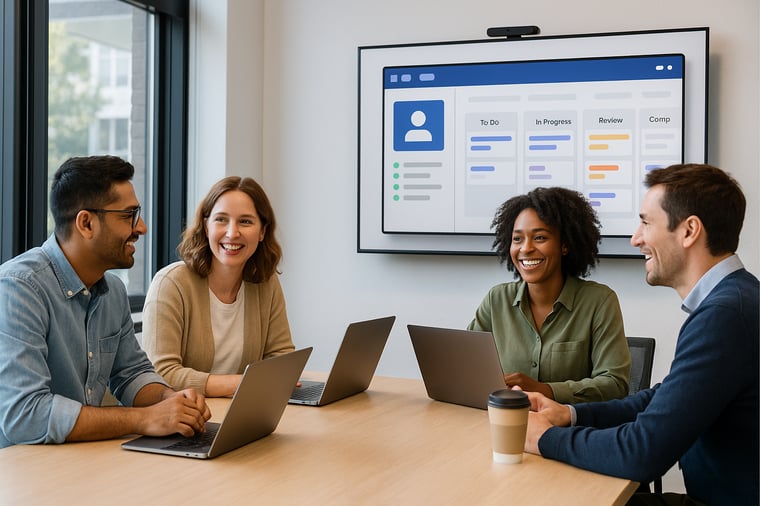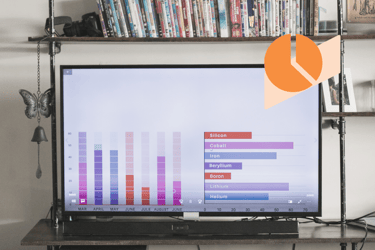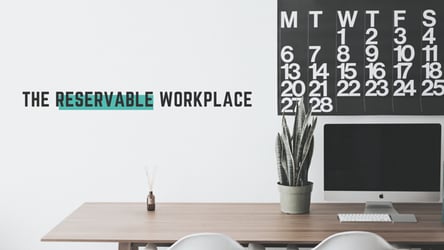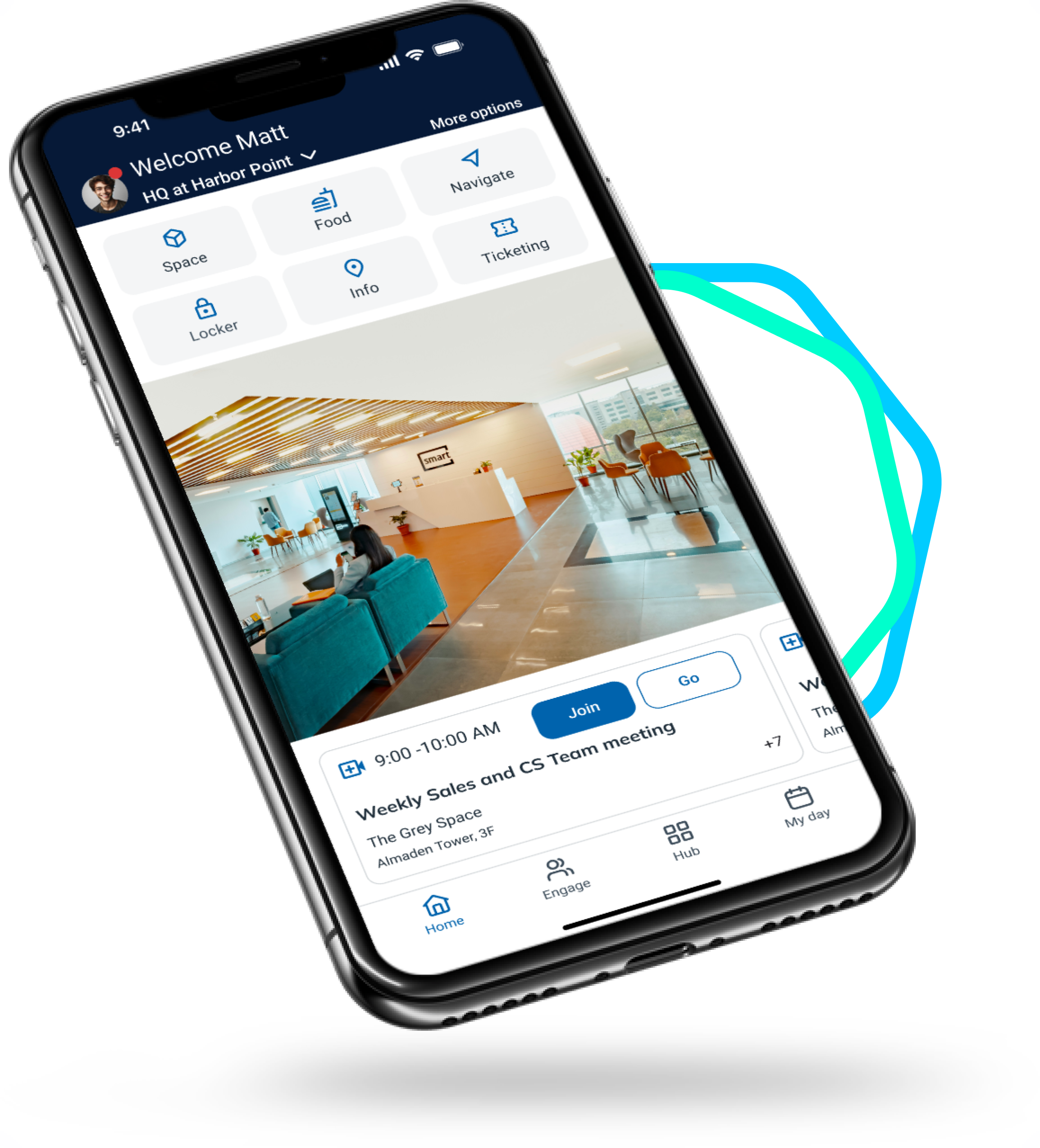From Return-to-Office to Return-on-Experience: Redefining Work in 2025
May 7, 2025 CXAI Team
The Hybrid Workplace Reality Check
Many large enterprises are grappling with a broken workplace experience. Poor space utilization, low in-person engagement, fragmented tech ecosystems – these issues have become common in the era of hybrid work and return-to-office (RTO) mandates. And they’re more than minor hiccups; they’re quietly undermining productivity, talent retention, and company culture.
Let’s unpack these challenges and why they persist – and more importantly, how we can boldly reimagine the workplace experience with modern, AI-driven solutions.
The Biggest Workplace Experience Challenges Today
-
Underutilized to Overcrowded Office Space: Until late 2024, offices felt like ghost towns on some days and scramble for space on others. In fact, 87% of organizations worldwide now operate with a hybrid work model, and nearly 80% cite optimizing space utilization as a top reason for it. Yet despite downsizing real estate, many executives are doubling down on RTO mandates. The result? Dissonance and frustration between leaders and workers. Companies invested in desk-booking systems to manage the RTO surge, only to find usage dropping as not enough employees show up at once – over half of workplace app vendors report significantly decreased demand for desk booking features throughout 2023-2024. Simply put, much of our pricey office space is sitting idle or mismatched to actual needs.
But over the course of 2024 and into 2025, we started to see a sharp shift. Space utilization and reservations quickly became the frontrunners in workplace challenges this time because of real surges in office attendance driven by stricter RTO mandates. This put intense pressure not only on the workplace leaders trying to manage the environment but also on employees, who suddenly found themselves crammed into spaces that couldn't handle the volume. The stress and frustration have flipped — from "too empty" to "way too full" — and many companies are now struggling with how to quickly adapt to this new, overcrowded reality.

-
Low Employee Engagement on Site: Mandating attendance doesn’t equal engagement. Many employees comply with RTO rules but feel disengaged when in the office. Why? Some arrive only to spend the day in virtual meetings because teammates or clients are remote. Others feel the in-office experience doesn’t justify the commute – there’s no buzz, no spontaneous collaboration, just the same work at a different desk. While leaders tout office culture and productivity, evidence shows office-based work isn’t automatically a magic bullet – hybrid employees are no less productive or engaged than office-only ones, and forcing office time can even hurt morale. With work-life balance and flexibility now top factors in employees’ career decisions (Gartner), a poorly executed RTO can tank morale. The younger workforce (Gen Z and millennials), in particular, won’t hesitate to leave if a company’s stance on flexibility and digital ease doesn’t meet their expectations.
-
Fragmented Tech and “App Fatigue”: Large enterprises often have a maze of siloed applications for workplace tasks. One app to reserve a desk, another to schedule meetings, separate platforms for HR, facilities, visitor check-in, you name it. This tech fragmentation creates a disjointed experience. Employees waste time toggling between systems and remembering multiple logins – a recipe for frustration and lost productivity. (How many browser tabs or mobile apps do you need just to get through one day at the office?) There’s a growing sense of digital friction at work: the tools meant to streamline work have ironically become work themselves. When compared to the seamless, unified apps we use in our personal lives, antiquated workplace tech can feel like a bad time warp, especially to digital natives. It’s no surprise engagement suffers when employees have to be their own IT integrators just to accomplish basic tasks.
-
Outdated Systems and Processes: Many companies are clinging to legacy workplace systems and manual processes that haven’t kept up with how work has evolved. Think of badge systems, intranets, or room booking tools from a decade ago – they often lack mobile access, intelligence, or integration. Meanwhile, work itself is now a fluid mix of digital and physical interactions. Processes designed for the old 9-to-5, one-location world crumble under hybrid complexity. Example: an office visitor policy that assumes a receptionist and paper logs, when in reality, visits now need digital pre-registration and automated check-ins. These outdated approaches persist due to unclear ownership between IT/HR/Facilities, or fear of disruption. But keeping them is risky – not only do they frustrate employees, they can pose security and compliance gaps (e.g. out-of-date emergency info or inconsistent health protocols across sites).
Why Do These Issues Persist? (The Root Causes)
It’s 2025 – how are large enterprises still stuck with such workplace experience pains? A few culprits:
-
Siloed Decision-Making: Responsibility for “workplace experience” often falls between the cracks of Real Estate, HR, IT, Facilities, and corporate leadership. Without a cross-functional team championing a unified strategy, efforts remain fragmented. One team deploys a new app while another cuts real estate, rarely syncing up to craft a cohesive experience. (Gartner recommends forming a WEX working group with HR, Facilities, IT, and employee champions to tackle RTO and workplace initiatives together.)
-
Old Habits & Assumptions: There’s an enduring mindset that being in the office = working. Many executives enforcing RTO assume more butts-in-seats will magically restore culture and collaboration. In reality, forced presence without support can backfire – Gartner warns it can “severely damage” an organization’s ability to attract and retain talent if not done with the employee experience in mind. Yet, some leaders persist with 20th-century thinking, focusing on attendance over experience.
-
Technology Lag and Sprawl: Upgrading workplace technology is often seen as costly and complex, leading to patchwork solutions. Enterprises bolt on new tools one by one (for food ordering, parking, room booking, etc.) rather than overhauling the core experience. Over time, this creates a spaghetti of apps that don’t talk to each other, and nobody steps back to redesign it. Additionally, some IT departments are cautious – they stick to incumbent vendors or in-house systems, even if better integrated solutions exist, due to concerns about security or disruption. The result is a tech stack that grows older and more convoluted each year.
-
Lack of Employee-Centric Design: Decisions about office setup or tools are sometimes made with insufficient employee input. How often have executives been surprised by low office turnout after investing in a fancy cafeteria or game room? It happens when you don’t ask employees what they value. If leadership hasn’t surveyed or observed what employees truly need to be productive and happy on-site, they might invest in the wrong things (e.g. renovating offices but neglecting remote connectivity issues or commute pain points). This misalignment lets problems fester – for example, a cumbersome travel approval process might keep people from coming in for team events, but leadership chalks up low attendance to “laziness” rather than to fix the process. In short, ignoring the employee voice perpetuates a poor experience.
The High Stakes: Why a Poor Workplace Experience Hurts Business
These issues aren’t just annoyances – they carry real risks for organizations:
-
Productivity Drain: When an employee spends the first 20 minutes of their day hunting for a desk or troubleshooting a conference room login, that’s lost output. Multiply that across thousands of employees and hundreds of workdays. Fragmented systems also mean people spend more time on “work about work” (scheduling, searching, setting up) instead of deep work. It’s estimated that digital friction and context-switching take a significant chunk out of the workday. And consider meetings: if joining a hybrid meeting in a conference room is a technical nightmare, employees will avoid those rooms altogether. Gartner says by 2025 over 65% of workers will choose to join hybrid meetings from their own desk rather than a conference room (likely to dodge poor tech setups.) All of this translates to productivity losses and frustration that flies under the radar.
-
Talent Retention and Recruitment: Culture and flexibility are make-or-break for talent. If your workplace experience is a drag, your best people have options elsewhere. A rigid RTO policy without flexibility or modern tools can spark higher turnover – employees may vote with their feet and leave for companies offering a better balance. Surveys show employees, especially Gen Z and millennials, prioritize work-life balance and flexibility on par with pay (Gartner). If they feel an RTO mandate threatens those, they’ll walk. Additionally, top candidates assess your workplace tech during recruitment. Handing them a thick badge and a stack of onboarding forms is not the same as a smooth, digital “welcome” via an app. Companies risk branding themselves as outdated. The cost? Losing out on top talent or paying a premium to hire because of a less attractive work environment.
-
Erosion of Company Culture: Ironically, heavy-handed RTO efforts meant to improve culture can damage it if employees perceive a lack of trust or empathy. Mandates without support send the message that leadership is out of touch. Over time, this breeds resentment and erodes engagement. On the flip side, a well-crafted workplace experience can strengthen culture by fostering genuine connection (both in-person and virtual) and showing employees they’re valued. Miss the mark, and you get a disconnect: in-office cliques vs. remote resentments, or an apathetic “quiet quitting” atmosphere. Culture is hard to measure, but you’ll feel it in lack of innovation, poor cross-team collaboration, and employees not going the extra mile. A modern, engaging workplace experience is becoming a competitive differentiator for culture – and those who ignore that do so at their peril.
In short, keeping the status quo isn’t just a facilities issue; it’s a strategic risk. As one Gartner analysis put it, even as leaders push for more in-person work, hybrid work isn’t going away – by 2026, over 80% of desk-based employees will seek to spend at least half their time working remotely. The organizations that thrive will be those that adapt the workplace to how work has changed, instead of trying to drag employees back into an outdated model.
Reimagining the Workplace Experience: From Mandate to Magnet
So what’s the answer? It’s clear that just tightening RTO policies or adding one-off tech tools won’t solve the deeper problem. It’s time to reimagine the workplace experience from the ground up – to transform the office from a mandate (“you must be here”) to a magnet (“you want to be here”).
At a high level, that means bridging the gap between the digital and physical workplace. Employees shouldn’t feel like they leave behind a convenient digital world when they step into the office. The office itself should be smart, connected, and responsive – essentially an extension of our digital lives, not a disconnect.
Imagine this: When an employee plans their week, an intelligent system suggests the best days to come into the office – days when their teammates or cross-functional partners will also be around, and when there are meaningful in-person activities scheduled. Upon arrival at the office, their smartphone doubles as their all-access pass: it opens the garage and front door, greets them with the day’s events, and navigates them to a desk near their project team. Throughout the day, it might ping them that “Project X’s design review is starting in 10 minutes in Room 500 – click here to join or find the room,” or remind them to take a stretch break between back-to-back meetings. After they head home, the system analyzes space usage and feedback, learning that the new collaboration area was empty all afternoon – prompting the workplace team to investigate why.
This isn’t a futurist’s daydream. This is the kind of seamless, AI-powered workplace experience that’s now possible by leveraging modern technology – effectively, bringing the convenience of a personalized app ecosystem into the workplace. It means treating the employee experience with the same thoughtfulness and integration that we treat customer experience. Just as we use data and AI to personalize customer journeys, we can do the same for employees in their day-to-day work life.
A key part of this reimagining is acknowledging that people’s expectations have changed. They compare their workplace to the ease of their smartphone apps. They expect things to “just work” and even to anticipate their needs. And frankly, they don’t want to use 10 different tools to do 10 different things when one smart platform could do it all. This is where the concept of a unified AI workplace app comes in – and it’s poised to be a game-changer.
One App to Rule Them All – Meet CXAI
CXAI is a single, unified, and AI-powered platform, that consolidates all aspects of the workplace experience. Instead of separate siloed apps and systems, the platform acts as the central hub for employees – essentially a one-stop-shop that blends the digital and physical workplace. CXAI is the solution our team has developed to address exactly these challenges.  So, what does a Workplace Experience (WEX) platform like CXAI do differently? In a nutshell, it tackles the very pain points we discussed with an end-to-end, AI-driven approach. Here are some of the standout capabilities:
So, what does a Workplace Experience (WEX) platform like CXAI do differently? In a nutshell, it tackles the very pain points we discussed with an end-to-end, AI-driven approach. Here are some of the standout capabilities:
-
Unified Access & Services: Say goodbye to app overload. CXAI brings everything employees need into one place — booking a desk, reserving a room, checking into the building, catching up on company news, even ordering lunch. Instead of juggling different logins or clunky tools, it all lives inside a single mobile app that’s connected to your badge system, Wi-Fi, calendars, and workplace services. One login. One less thing standing between employees and a smooth, productive day.
-
Smart Wayfinding & Workspace Booking: Large campus or new office layout? No problem. The app includes interactive maps and smart wayfinding to guide employees and visitors to conference rooms, desks, or colleagues’ locations. Need a quiet space for focus work? CXAI can show available rooms or pods nearby and let you reserve them on the spot. This addresses the “where do I go?” anxiety that often plagues hybrid offices. It’s like having a GPS for your workplace – incredibly useful when people are in-office only a few days a week and not intimately familiar with every floor.
-
Personalized AI Nudges: An AI assistant within the app learns your preferences (with privacy in mind) and offers thoughtful suggestions: like booking a desk near your team, taking a stretch break after back-to-back meetings, or joining a pop-up event happening down the hall. These personalized nudges can also help with engagement – for instance, reminding you that a few teammates you often collaborate with are in today or prompting you to join other wellness activities. It can even surface safety alerts or remind someone to unplug with a PTO day. Little nudges, big impact — they help employees feel seen, supported, and a little more human at work.
-
End-to-End Experiential Analytics: Here’s where the “superpower” for leaders comes in. A workplace experience app like CXAI doesn’t just provide functionality – it also gathers experiential analytics (in aggregate, ethically) about how spaces and services are used. Think real-time dashboards showing office occupancy trends, popular days vs. slow days, which amenities are most used, and even sentiment analysis from pulse surveys. This data is gold for Real Estate, Facilities and HR. It means you can finally measure the workplace experience in concrete terms – and continuously improve it. For instance, if analytics show the new collaboration zone isn’t being used in the afternoons, you can investigate (maybe it’s too cold, or people don’t know about it) and fix it. Or if the data shows that a huge chunk of employees struggle to find parking and desks on Mondays, you might stagger team anchor days. Unlike the old days of guesswork, leaders can now make data-driven decisions to refine office design, adjust policies, and target investments – whether that’s adding more standing desks or launching a new shuttle service for better commute experience.
-
Intelligent Space Management:
Building on experiential analytics, CXAI empowers workplace leaders with real-time insights into how spaces are actually used. Facilities teams can spot trends like underutilized desk areas, high-demand conference rooms, or low-traffic zones — and adapt layouts accordingly. Instead of guessing, leaders get the data they need to convert underused areas into collaboration spaces, optimize floor plans, and align the workplace to hybrid work patterns in real time — not months or years behind evolving needs.
-
Well-Being and Community Building: A truly modern workplace app doesn’t ignore employee well-being – in fact, it weaves it into the experience. CXAI supports this by delivering a unified experience where employees can easily discover wellness programs, onsite events, company initiatives, and local activities — all through a single platform. Whether it’s participating in a volunteer day, attending a lunch-and-learn, or joining a fitness challenge, CXAI helps foster the spontaneous, human moments that build community and strengthen culture in a hybrid world. All of this signals to employees that their company cares about them as people, not just “workers,” enhancing that emotional connection to the workplace.
-
Compliance and Safety Automation: Remember those outdated processes? Here’s the fix. CXAI automates compliance tasks in the background. Employees and visitors can complete any necessary security checks right in the app. Emergency drills or notifications can be delivered through it, ensuring everyone gets the memo. And forget the clipboard sign-ins – visitor info is captured digitally, and hosts get alerts when their guest arrives. This reduces administrative burdens on staff and provides a consistent, audit-ready trail for compliance. In high-security or regulated industries, having this centralized is a huge relief (and reduces the chance of human error in critical procedures). Whether it’s delivering a building-wide alert, logging visitor data automatically, or enabling seamless entry protocols, CXAI helps organizations raise their security and compliance standards while eliminating friction.
All these features are integrated under one umbrella, powered by AI and IoT connectivity. If “dumb things” like doors, lights, and coffee machines are getting smart, CXAI is what lets employees actually use that intelligence easily. Early workplace apps mainly just automated a few tasks; now, with AI, they can deliver conversational interfaces and smart assistance – think chatbots to answer "Where’s an open meeting room?" or "Book function hall 1 and add catering.” The goal is to remove friction at every step and even add a touch of delight.
Importantly, a platform like CXAI doesn’t replace human connection – it enhances it. By handling the mundane (finding a room, logging a ticket) and surfacing useful info (who’s in office, what events are happening), it frees employees to focus on high-value interactions. The office can become what it should be: a collaborative, engaging hub of creativity and teamwork, supported by technology that “gets out of the way” when not needed and offers a helpful hand when it is.

Photo by Brooke Cagle on Unsplash
And the impact is tangible. Companies that embrace such unified solutions have seen higher in-office participation (because the experience is better), improved feedback on workplace services, and more efficient use of space and resources. It turns the office into a place designed around the employee experience– which is exactly what today’s workforce has been asking for.
In fact, industry analysts are taking note. Gartner’s 2024 Market Guide for Workplace Experience Apps recommends delivering “personalized, consumer-like experiences” and eliminating the friction of multi-app environments by deploying a single branded workplace app. The writing on the wall is clear: those who unify and modernize will leap ahead, and those who don’t will keep struggling with underused offices and unhappy staff.
Practical Recommendations for Workplace Leaders
Modernizing your workplace experience might sound daunting, but it doesn’t have to be an all-at-once moonshot. Here are some practical steps and recommendations for leaders looking to turn these ideas into action:
-
Form a Cross-Functional “WEX” Team: Break the silos by creating a workplace experience task force that includes HR, IT, Facilities, and employee representatives. Empower them to holistically design and drive the workplace experience strategy (Gartner). This team should regularly gather employee feedback and coordinate initiatives so that technology, space design, and policies are aligned toward the same goal.
-
Map the Employee Journey & Pain Points: Take a cue from customer experience playbooks – map out a day in the life of your employees. How do they start their day? Where do they get stuck or frustrated? Use surveys, focus groups, and data (like helpdesk tickets or space usage stats) to identify friction points file (Gartner). For example, if employees dread finding a parking spot or think booking a meeting room is a hassle, those are priority areas to fix. Understanding these journeys will help you prioritize which improvements will matter most to your people.
-
Prioritize a Unified App Strategy: Audit your current workplace tools and assess which can be integrated or phased out. Aim to consolidate into one platform wherever possible – it will simplify life for employees (and reduce costs long-term). The goal is to eliminate the patchwork of apps and give people a one-stop, cohesive experience.
-
Leverage AI – But Start with Basics: Don’t pursue AI for buzzword’s sake; align it to your use cases. Maybe you start with something straightforward like a chatbot for office FAQs or an AI-driven desk allocation that clusters teams together on given days. When choosing a platform, look at its current and future AI capabilities – does it support things like plug-and-play language models or advanced analytics? (Gartner). These will be increasingly important. However, ensure you have the basics (like reliable Wi-Fi, up-to-date video conferencing gear) in place first, or even the smartest app won’t save you from tech headaches.
-
Revamp the Office Space with Data: Use occupancy and utilization data to drive your space planning. If only 30% of desks are used on average, consider creating more collaboration zones or quiet rooms in place of rows of empties. If certain days are over capacity, consider team “anchor days” or incentive schemes to spread usage. Also, invest in modernizing key collaboration spaces: e.g. upgrade meeting rooms with better video/audio to support hybrid meetings (since a majority of people prefer joining from their own device, conference rooms need to earn their attendance by being truly seamless (Gartner). The key is to adapt the physical environment continuously based on what’s actually happening, not a fixed plan from last year.
-
Make Flexibility a Policy (Not a Perk): The data is conclusive – flexibility drives people back more than force. By 2028, 60% of workers will voluntarily return to office if they have flexible start/end times, and a sizable share of companies may even shorten workdays to encourage in-person presence (Gartner). Embrace this. Could you allow 7-3 or 10-6 schedules, so people can dodge traffic or do school drop-offs? Can you designate “core hours” instead of strict 9-5? Perhaps offer an option to leave early on office days once essential meetings are done. Such moves show respect for employees’ time and actually entice them to come in. Flexibility and a great experience are not at odds – they work hand in hand to make the office a place that fits into employees’ lives.
-
Communicate and Iterate: Roll out changes with strong communication. Explain to employees why you’re introducing a new app or reconfiguring the office — and always tie it back to what’s in it for them. Provide training sessions or “office hours” for new tools so no one feels left behind. Then, measure the impact and gather feedback. Treat this as an ongoing journey: track app usage, run quick pulse surveys, and be ready to adjust based on what you learn.
Maybe you launched a new feature for reserving focus rooms — but discover employees aren’t using it because the signage on-site is unclear, or the rooms aren’t well located. Find out why and fix it. Showing you’re listening — and improving — builds trust. Employees will see that it’s not change for change’s sake, but a genuine effort to create a better workplace experience for everyone.
By following these steps, leaders can build a workplace tech stack and culture that are resilient and adaptive. The payoff will be evident in higher employee satisfaction, smoother operations, and better utilization of your office investments.
Conclusion: Elevate Experience to Unlock Performance
The message is loud and clear: workplace experience is the new cornerstone of the future of work. It’s no longer a “nice to have” – it’s directly tied to productivity, innovation, and staying competitive in hiring. In an age where hybrid work is here to stay, companies must shift from viewing the office as a simple container for workers to viewing it as a platform for experiences. That means melding the best of digital convenience with the irreplaceable benefits of face-to-face interaction.
The good news is that the tools and tech to do this are available now. AI and IoT are infusing intelligence into buildings, and solutions like CXAI’s Workplace Experience App are making it practical to orchestrate all these moving parts and deliver a unified experience. With the right strategy, you can transform your workplace from a source of frustration into a hub of engagement and excellence. Imagine employees who are excited to come in because it’s easier, enjoyable, and energizing – that’s not a dream, it’s an outcome within reach.
It’s time to act. Start a conversation within your leadership team about reimagining your workplace experience. Share this article with colleagues who need a spark of inspiration. And we’d love to hear from you – how is your organization tackling these WEX challenges? If you’re curious about how a solution like CXAI can fit into your strategy, let’s connect. Together, let’s make the workplace something people love, not leave.
Let’s Build the Future of Work Together
At CXAI, we believe technology should make work more human — not more complicated.
If you're rethinking how your workplace can better serve your people and your business, we’d love to show you how our platform can help. CXAI Apps provide your employees a seamless, consistent experience across all devices - from wearables and mobile phones to PCs and Kiosks. With CXAI VU, you gain powerful analytics and insights to help predict outcomes and improve decision-making. All of this is powered by our enterprise-grade CXAI BTS rule engine, designed to boost employee productivity and engagement in a secure environment.
Let’s schedule a walkthrough. See what a truly modern, unified workplace experience looks like — and how it can drive real impact for your organization.
Learn more about CXAI at www.cxai.ai.
Sources:
- Gartner, 2024 Market Guide for Workplace Experience Applications
- Gartner, Return to Office Strategy Research, 2024
- HRD Asia, “80% of Organizations Prioritize Space Utilization in the Hybrid Era”
- JLL, Future of Work Survey 2022
- McKinsey & Company, Future of Hybrid Work Study 2022
- Gensler, U.S. Workplace Survey 2022-2023

.png)

.png)






